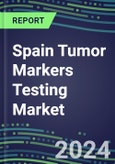This report is a study of the major business opportunities emerging in the Spanish cancer diagnostics market during the next five years.
The report examines trends in the Spanish cancer diagnostics markets, reviews current and emerging assays; analyzes potential applications of new diagnostic technologies; forecasts sales of major tumor markers by market segment; profiles leading players and potential market entrants; and identifies specific business opportunities for suppliers.
Rationale
The cancer diagnostics market is on the verge of explosion, as the researchers approach major technological breakthroughs in tumor diagnosis and therapy, discover new specific antigens, and unlock the mystery of the genetic basis of the disease. During the next five years, the worldwide cancer diagnostics market is promising to be an exciting, dynamic and rapidly expanding field. Anticipated technological breakthroughs will create numerous opportunities for determining genetic predisposition, detecting specific tumors, and monitoring biological response to cancer therapy. The rise in geriatric population will further compound the growing demand for malignancy assays and the rapid market expansion worldwide.
Spain Market Overview
The report examines trends in the Spanish cancer diagnostics markets, reviews current and emerging assays; analyzes potential applications of new diagnostic technologies; forecasts sales of major tumor markers by market segment; profiles leading players and potential market entrants; and identifies specific business opportunities for suppliers.
Rationale
The cancer diagnostics market is on the verge of explosion, as the researchers approach major technological breakthroughs in tumor diagnosis and therapy, discover new specific antigens, and unlock the mystery of the genetic basis of the disease. During the next five years, the worldwide cancer diagnostics market is promising to be an exciting, dynamic and rapidly expanding field. Anticipated technological breakthroughs will create numerous opportunities for determining genetic predisposition, detecting specific tumors, and monitoring biological response to cancer therapy. The rise in geriatric population will further compound the growing demand for malignancy assays and the rapid market expansion worldwide.
Spain Market Overview
- Five-year test volume and sales projections.
- Comprehensive market segmentation analysis, including review of the market dynamics, structure, size, growth and major suppliers.
- Estimated universe of laboratories performing cancer diagnostic testing.
- Cancer statistics, etiology and recent developments.
- Specific new product development opportunities with potentially significant market appeal during the next five years.
- Design criteria for new products.
- Alternative market penetration strategies.
- Potential market entry barriers and risks.
- Biochemical Markers
- Oncogenes
- Growth Factors
- Hormones
- Colony Stimulating Factors
- Lymphokines
- Immunohistochemical Stains, and others.
- ACTH, AFP, Beta-2 Microglobulin, CA 15-3/27.29, CA 19-9, CA 125, Calcitonin, Cathepsin, CEA, Chromogranin, Colon-Specific Antigen, Cytokeratins, Estrogen Receptor, Ferritin, Gastrin, HCG, Insulin, Interferons, Interleukins, Lymphocyte Subtyping, Neuron-Specific Enolase, Nucleolar, Occult Blood, Oncogenes, Pancreatic Oncofetal Antigen, Pap Smear, Parathyroid Hormone, Progesterone Receptor, Prostatic Acid Phosphatase, Prostatic Specific Antigen, S-100 Protein, Serotonin, Sialic Acid, Squamous Cell Carcinoma Ag, TDT, Thymidine Kinase, Thyroglobulin, Tissue Polypeptide Antigen, and others.
- Sales and market shares of major cancer diagnostic product suppliers by individual test.
- Five-year test volume and sales forecasts for major tumor markers by market segment, including:
- Hospitals
- Commercial/Private Laboratories
- Analysis of major molecular diagnostic and immunodiagnostic analyzers used for cancer testing, including their operating characteristics, features and selling prices.
- Assessment of latest molecular diagnostic methods, biochips/microarrays, biosensors, monoclonal antibodies, immunoassays,
- Review of competing/complementing technologies, including CT, MRI, NMR, PET and photonics spectroscopy.
- Extensive listings of companies, universities and research centers developing new cancer diagnostic tests and detection technologies.
- Strategic assessments of major suppliers and start-up firms developing innovative technologies and products, including their sales, product portfolios, marketing tactics, collaborative arrangements, and new products in R&D.








